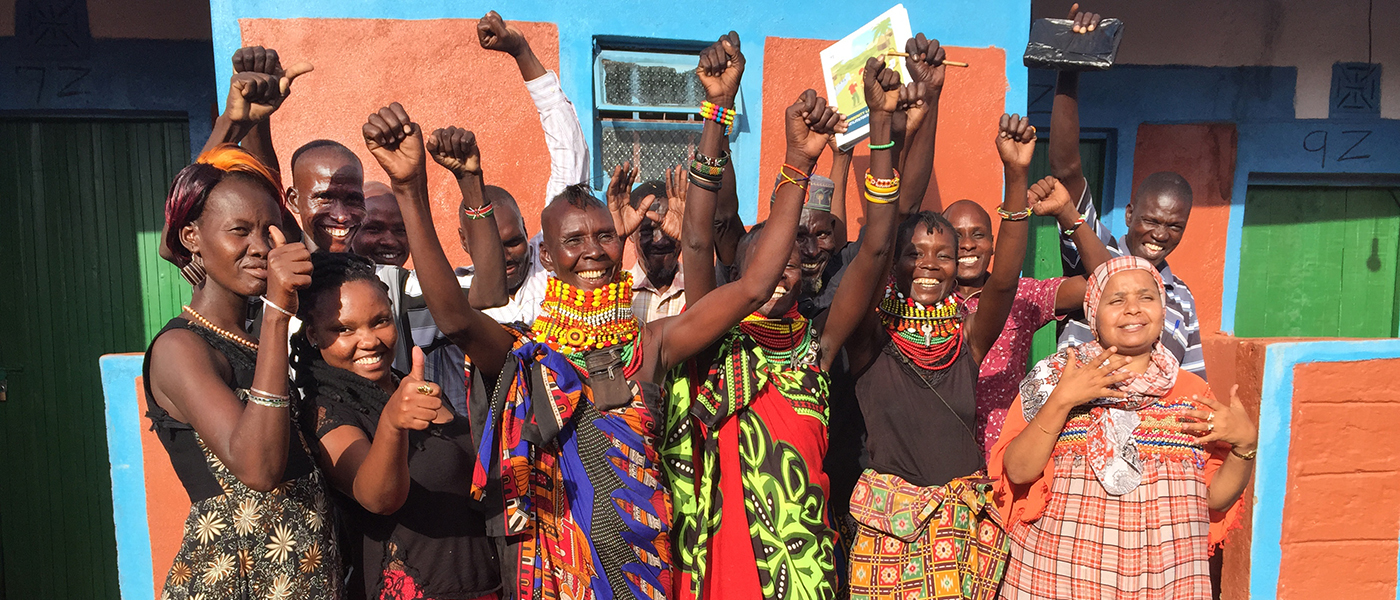News & Blogs
Addressing Land Conflict & Governance in Kenya
Namati Training Visit to Turkana and Tana River
December 2015
By Marena Brinkhurst, Program Associate, Community Land Protection Program
In October, I and Program Director Rachael Knight visited Kenya, where the Kenya Land Alliance and Oxfam are implementing Namati’s community land protection approach in Turkana and Tana River counties. Teams of KLA staff Community Facilitators and community-based Land Rights Mobilizers are supporting 15 pilot communities to formally claim their community lands, resolve long-standing land conflicts, and respond to oil exploration and industrial land development in their territories. We visited the teams to learn about their work on the ground and to prepare them to support communities through the next steps of the community land protection process: negotiating boundaries with neighboring communities, resolving land conflicts, and drafting by-laws to strengthen community governance of lands and natural resources.

Turkana
Flying over Turkana, it is easy to assume that it is a vast, sparse desert. But up close, the landscape is surprisingly dynamic: wide dry riverbeds come alive in sudden rainfall floods, sharp outcroppings of red-brown rock serrate the horizon, camels weave in and out of spiky trees, and, hidden underground, newly-discovered oil reserves are sparking an oil development boom in this once isolated region.
In Turkana, pastoralist communities depend upon access to vast areas of intensely arid grazing lands to survive. Yet local communities are increasingly coming into conflict with booming oil exploration and associated land development activities. The small, but rapidly growing, town of Lokichar exemplifies these changes: new businesses have sprung up along the main road, massive water trucks and oil company equipment are parked everywhere, and loitering teenagers watch for chances to earn some cash. In the words of Lokai Charles, one of KLA’s Turkana Community Facilitators: “Communities are feeling the pressure on their lands and are worried about how fast things are changing.”
During the first part of our visit, the eleven Mobilizers and two Facilitators described their work in communities to date: they had introduced all the steps of the community land protection process; worked to ensure full community participation, including women and youth; provided basic legal education about land rights in Kenya; built community motivation and unity; led “visioning” meetings to help each community articulate its vision for the future; estimated the value of the community’s land-based resources; and established each community’s team of Mobilizers and a representative coordinating committee of community members. Their efforts have already had a positive impact: Moses, one of the Mobilizers from Lomokomar (a community whose land already contains three oil wells, another 18 surveyed well sites, and will likely include parts of the planned LAPSSET roads, pipelines, and railway lines) described how “Before this work, Lomokomar was like any other pastoralist community, not empowered. Now because they know the truth [about the law] and their rights, they are even trying to scare away elites who are coming for land.”
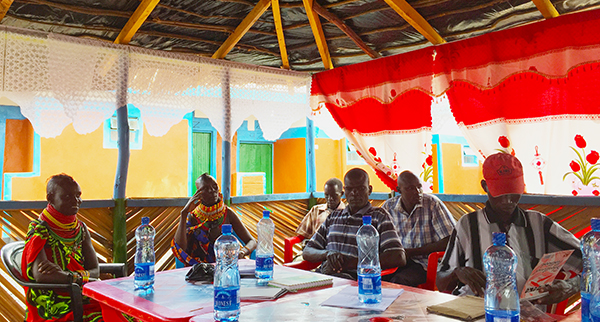 The mobilizers shared updates from their communities
The mobilizers shared updates from their communities
Sitting together in a shaded pavilion as temperatures climbed to 40°C, we reviewed recommendations for how to support communities during the often time-intensive and challenging next steps of negotiating boundaries and drafting community by-laws for local land governance. The Mobilizers discussed several boundary conflicts that they are already concerned about: People in Lokichar town are claiming pieces of Lomokomar’s lands in hopes of benefiting from the oil rush; Lokapel is struggling with a neighboring Chief who is claiming control of lands beyond traditional boundaries; and the Chiefs of Lokichada and Kapese disagree on the location of their boundary.
Namati and KLA offered lessons and strategies from communities’ experiences elsewhere, and asked the Mobilizers to think critically and creatively about what conflict resolution strategies might work well in their communities. The eldest Mobilizer described traditional mechanisms for mediating conflicts: “First investigate where the conflict arises, who is making the conflict, once finding who is causing the community go and speak with that person, talk to both communities, if guilt can be found then call a community meeting to resolve.” We also discussed how to approach disagreements that may not involve guilt, but rather just a lack of clarity on boundaries. We shared examples of how compromise is often possible after both sides share their perspectives and histories. The Mobilizers agreed, telling stories of how their Elders had resolved conflicts over boundaries or land use, reflecting that “Elders are best because they don’t fight, they listen.” Then Mobilizers did a series of role-plays to practice and internalize techniques for facilitating meetings and mediating conflicts – acting out many animated characters and scenarios, accompanied with many outbursts of laughter!
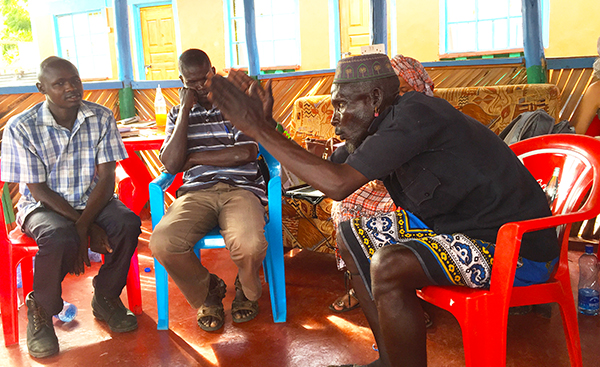 Turkana mobilizers role-play mediation techniques
Turkana mobilizers role-play mediation techniques
After another simulation, this time of a by-laws drafting process, the Mobilizers were full of questions: “What to do if communities’ rules did not agree with Kenyan laws?; How community title could protect against compulsory acquisition by the government?; How to handle land management rules that needed to be adaptable to changes in season and rain patterns?; How to balance the interests of community members who prefer traditional lifestyles and others who prefer ‘current lifestyles’?” We brainstormed strategies for discussing these and other questions and emphasized that community rules will be shaped by the preferences of each community – if they want to document only old rules, only new rules, or a mix, any approach is fine. We also coached the Mobilizers and Facilitators in how to gently support their communities through this process, such as pointing out draft rules that conflict with national law or human rights principles and asking strategic questions about situations that communities should prepare rules for, such as the process for deciding on a request by an investor.
To finish the training, we joined the community of Kapese to observe their first community sketch-mapping meeting. Kapese is at the forefront of the oil-driven land development in the region because it borders Lokichar town and is the site of many oil well sites developed by UK oil company Tullow Oil. Charles began the meeting with a discussion of the purposes of mapping and answered community questions about how mapping would support the larger community land protection process. After an explanation of how to create a sketch map, the meeting divided into men and women and soon began heated discussions while drawing large maps in the sand.
I joined the women’s group and watched as they drew a practice sketch map in the dry river bed. They took turns passing a drawing stick, debated locations, and watched carefully as lines were added. At first, the map was huge – with outer edges that stretched far beyond our seated group. With coaching from the Mobilizers, the women realized that they needed to reduce the size of their map in order to be able to look at it more easily. The sand map filled with lines of buildings, river beds, grazing areas, and access routes. Seeing it all together, I began to appreciate the vastness of the territory that the women were discussing.
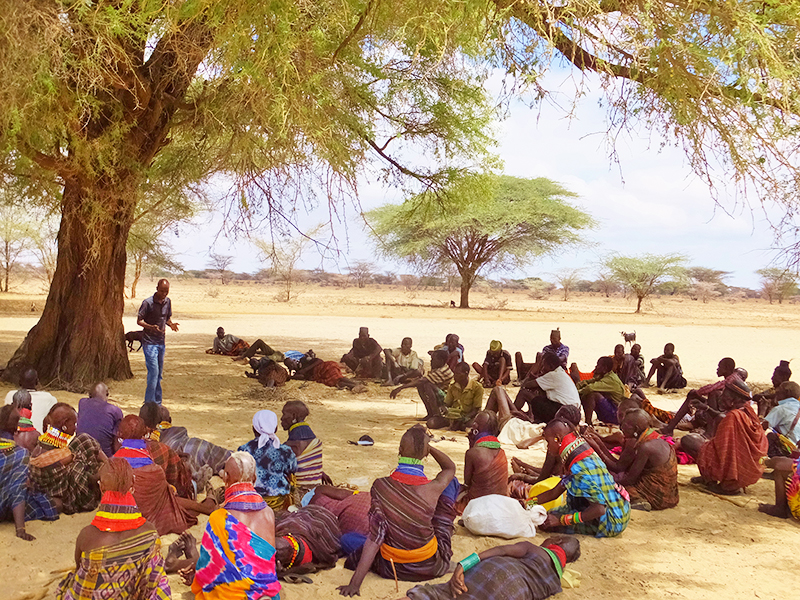
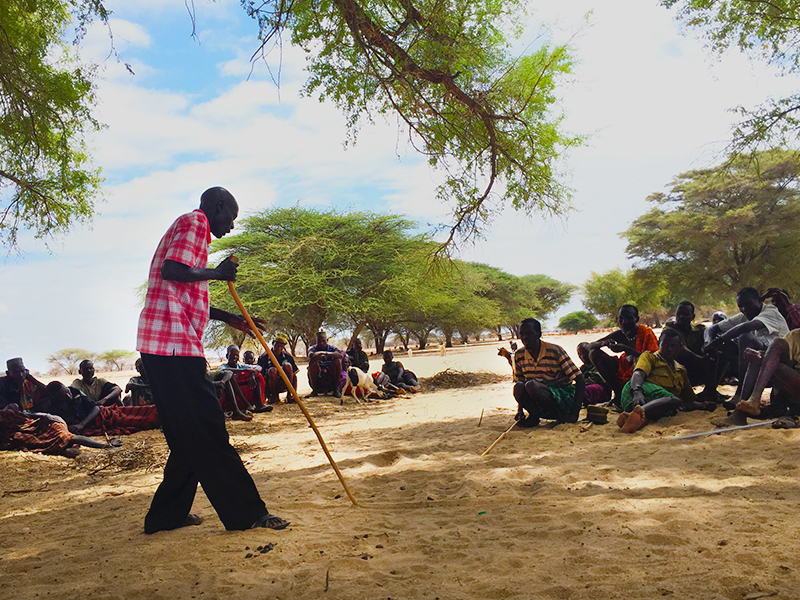
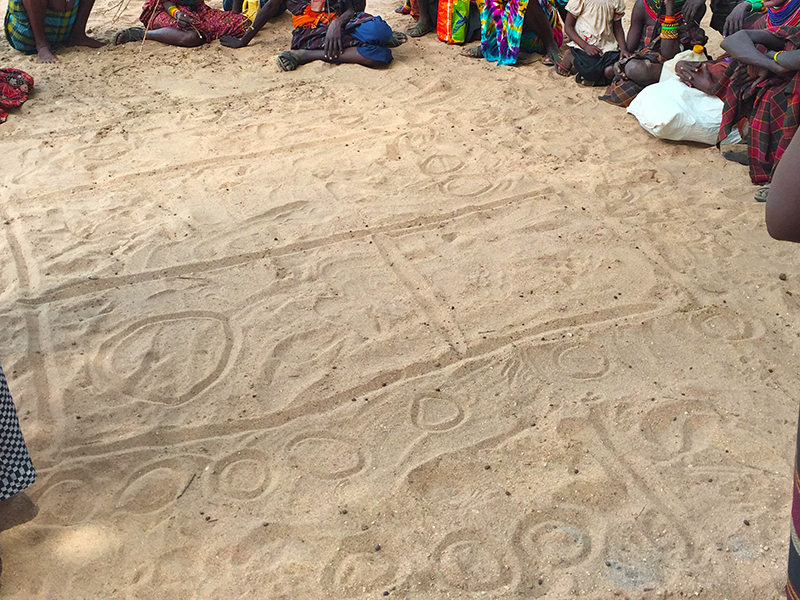
Sketch-mapping in Kapese – the circles on the right represent oil wells
But then Kapese’s lands began to shrink. One woman cut out a large rectangular swath near the center of the community: the area taken for the new airstrip, I was told. Then the women drew large circles all across the right-hand side of the map: oil wells that had been built and fenced off by Tullow Oil. Finally, a web of roads crisscrossed the remaining lands: built by oil company contractors to link the increasing number of wells, equipment storage sites, and camps. While sketch maps usually do not accurately show scale or relative size, they reflect the mappers’ perceptions of the landscape. It was clear even from this initial map that this group of women felt as though they could no longer use vast areas of their lands.
But the community land protection process is changing community attitudes: Lawrence, one of Kapese’s Mobilizers explained how community members are now empowered to take a stronger stand when Tullow meets with them. He described how: “In May, the community organized to meet with Tullow Oil about their plans to construct another road and told them that they did not want another road for Tullow. Now the people know the benefit that they get from the land, and so now they ask, ‘What are the benefits if an investor comes?’ and negotiate well… Tullow itself has realized that the community is more empowered now.”

Tana River
KLA is working with 10 communities in the Tana River Delta, a region struggling to heal from at times violent land-based conflicts between the pastoralist Orma and Wardeh tribes and the agriculturalist Pokomo tribe. In Tana River, we are supporting communities to not only document and protect their lands, but also to simultaneously resolve longstanding conflicts and help communities chart a course towards peaceful co-existence and collective land management.
As in Turkana, our time in Tana River began with a two-day intensive training, beginning with progress reports from the three KLA Community Facilitators and twenty-nine Land Rights Mobilizers. They also reflected on challenges associated with building trust in the process because of the sensitivity of land issues in the Delta. Recognizing the need for clear plans to reduce and manage conflicts in this region, KLA and Namati helped the Mobilizers prepare strategies to use during community boundary negotiations. As a group, we discussed types of conflicts that might arise, identified indicators of escalating tensions to watch for, developed strategies for managing potential conflicts, and mapped networks of people who Mobilizers and Facilitators could call to help in different kinds of conflict situations. Namati also trained the Mobilizers in basic mediation techniques for resolving boundary and land use disagreements. Then, the Mobilizers and Facilitators divided into small groups and role-played various sample conflict situations to practice their mediation skills.
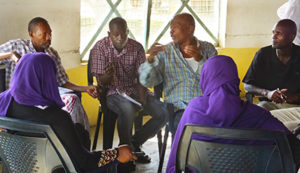
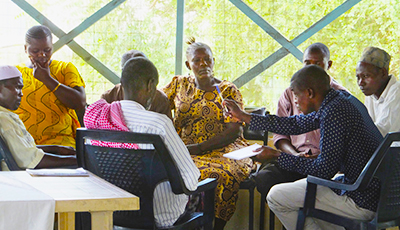
Small groups role-play mediation scenarios in Tana River
For the rest of the training, we focused on ensuring that the Facilitators and Mobilizers felt confident in facilitating a community by-laws drafting process. Rather than listing out steps and do’s and don’ts, we led the group through a detailed simulation of a by-laws process – starting with a “shouting out” of example existing community rules, all of which were recorded without debate as the first draft of by-laws. Then, jumping ahead to a “meeting” about the second draft, Mobilizers debated suggestions for rules to add, remove, or modify. Women met together to discuss changes that they wanted to see in the second draft, and agreed on strategies for how to advocate for those changes. Even the simulated arguments were heated – especially about the role of youth and women in decision making. Eventually the “community” agreed on a second draft of rules and enforcement strategies, which was then checked to ensure no rules contradicted national law and finally adopted by the “community” with a vote and celebration. The simulation took almost the entire day, but Namati’s approach to training is to illustrate through actions and scenarios as much as possible, to help people internalize what it feels like to do this work in their communities.
On our last day, we then visited the community of Chara to support the Mobilizers facilitate their first by-laws drafting meeting. Community members greeted us and called in a crowd with energetic renditions of traditional Pokomo songs and dances. Once a large, colorful crowd had gathered in the shady mango grove, KLA staff and Chara’s Mobilizers facilitated a session of “shouting out” the community’s existing and traditional rules. At first the discussion centered on rules for the use and management of lands and natural resources, and then moved onto questions of local land governance. The discussion was lively and interesting, but once the facilitator turned the discussion to social and cultural rules, the crowd came alive in a whole new way. Everyone – women, old men, and teenagers – had stories to share or examples to add. People were laughing, gesturing, acting, and arguing. One woman explained how it was the community’s rule that if a man beat his wife, all the other women of the community would rally and publicly shame the man until the other men of the community came to “help” him and counsel him on treating his wife with respect. An old man told stories about how in the past, parents would choose a spouse for their child in order to make a strong match. He acknowledged that this was no longer appropriate because of changes in culture and laws, but he told the group that he was concerned that the loss of parental involvement in their children’s relationships was weakening marriages and increasing teen pregnancy. Again and again, community members rose to speak about practices and rules that they knew about in their community – the by-laws drafting process had begun!
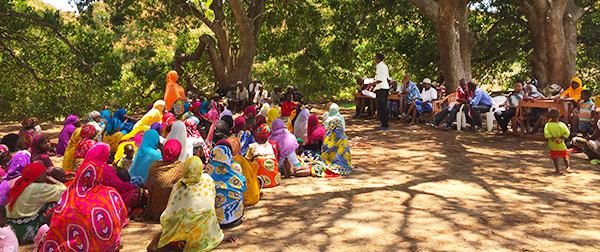
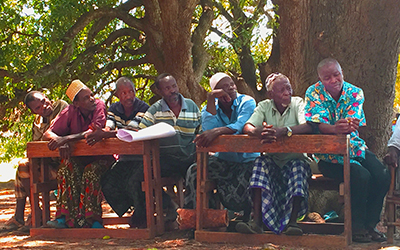
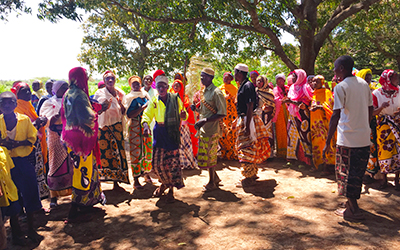
Chara community members discuss their local rules – and close with a dance
Watching this meeting was a watershed moment for Namati – we realized that cultural and social rules should not be sidelined or down-played in the community land protection process. In some communities, like Chara, it may be that cultural and social rules provide vital animating energy to carry a community through the long, and often unfamiliar, process of discussing, documenting, debating and publicly formalizing community rules. It was apparent that preserving and strengthening local culture can be a significant and tangible source of empowerment – in some cases perhaps even more so than changes in local land management or governance.
On the return from Chara, Community Facilitator Odha Ilu Hiyesa reflected on why he believes in community land protection work: “The volatility in this region is rooted in land matters. There are so many NGOs around, but the only organization with an idea for a solution on matter of land is KLA. If this project succeeds, the whole nation will follow.” His fellow Community Facilitator, Yusuf Omar Uleta, added that he was encouraged by the progress that communities were making and felt strongly that “The success of the project will be the happiness of the community, and the whole world will see that.”
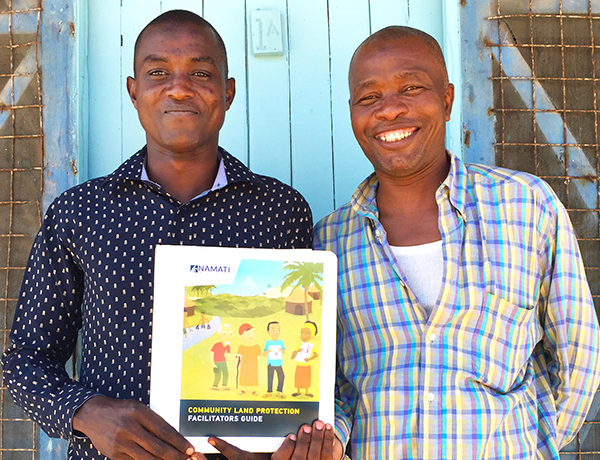
Community Facilitators in Tana River, Yusuf Omar Uleta and Odha Ilu Hiyesa,
with Namati’s new Community Land Protection facilitator’s guide.

